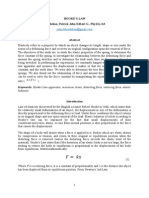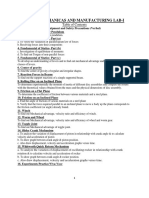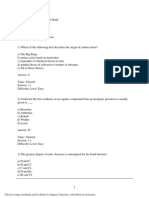Physics 1 Centripetal Force Lab
Physics 1 Centripetal Force Lab
Uploaded by
vietsasa22Copyright:
Available Formats
Physics 1 Centripetal Force Lab
Physics 1 Centripetal Force Lab
Uploaded by
vietsasa22Original Description:
Copyright
Available Formats
Share this document
Did you find this document useful?
Is this content inappropriate?
Copyright:
Available Formats
Physics 1 Centripetal Force Lab
Physics 1 Centripetal Force Lab
Uploaded by
vietsasa22Copyright:
Available Formats
Centripetal Force Introduction- The purpose of this lab was to determine the centripetal force acting on an object that
rotated in a circle and the relationship between FC, mass, and radius on the period of rotation of the object. Since the object is moving in a circle at a constant speed, we call this uniform circular motion. As the object moves in a circle, it accelerates and therefore requires an unbalanced force that prevents the object from moving in a straight line. This unbalanced force is a net inward force, or centripetal force (FC) that points in the same direction as the acceleration of the object -towards the center of the circle. Experimental Sketch- An apparatus was set up to rotate a bob in uniform circular motion and to measure the period of rotation of the bob. (See Fig. 1.) Procedure- In Study 1, an apparatus was set up to rotate a bob in uniform circular motion. The mass of the bob was measured. Then the bob was hung from a string on the cross arm of the apparatus. The radius of the circle was measured (distance from the base of the apparatus to the hanging bob). A weak spring was attached from the base to the bob. Next Fig. 1 A bob was hung on the static force of the spring on the bob was measured. A string a string from a cross arm tied to the bob was passed over a pulley and weights were added and pulled in towards the to a weight holder attached to the string until the bob stretched center by the spring (Fs). out to the exact radius that was measured earlier. This mass was recorded. Then the centripetal force of the bob was measured. The power supply was turned on and the voltage and current were adjusted accordingly so the bob would rotate and pass directly over the measured radius and underneath the photogate. Fifty revolutions of the bob were recorded on Capstone. This process was repeated again using a stronger spring. For Study 2, we measured the period for five different masses of the bob. For each mass, the revolution was measured in Capstone. Our data points were graphed and a linear line was obtained.
Data/CalculationsStudy 1 Constants:
Mass (M) of bob (kg) = 0.4822 kg M of bob (kg)= 5 x 10-5 Relative Error in M= 1.04 x 10-4 Radius-R (m) = 0.18 m R (m)= 0.005 Relative Error in R= 0.028 Bob at Rest Spring m2 (kg) m2 (kg) Fs (N) = (m2)*g Fs = g*(m2) Weak Spring 0.105 0.0025 1.029 0.0245 Strong Spring 0.205 0.0025 2.009 0.0245
Bob in Motion Spring N (# periods) T (s) (T) (s) T = (T) = (T)/ Relative Error in T Weak Spring 50 1.65 0.04 0.0057 0.0035 Strong Spring 50 1.20 0.02 0.0028 0.0023
-See attached data sheets for weak and strong spring (1) and (2). Study 2 Table of the different masses used and the period obtained from Capstone. -See attached graph (3)
# 1 2 3 4 5
Mass (kg) 0.4322 0.4022 0.3822 0.3722 0.3522
T2 1.26 1.24 1.23 1.22 1.21
Study 1 Analysis
Weak Spring 1.Static Force (Fs)
Strong Spring
2.Centripetal Force (Fc)
3.Greatest Source of Uncertainty
4.Difference between calculated Fc and measured Fs
5.Error in the difference
Fc= 1.26 0.035 N Fs= 1.029 0.0245 N
Fc= 2.38 0.067 N Fs= 2.009 0.0245 N
Lab DiagramBob at Rest Bob in Motion
Theory-We are comparing the two different forces Fc and Fs because we want to show that they are equal to each other. Discussion1. Fc and Fs do not agree within error. 2. If there is friction present on the pulley, then friction equals the difference between the Fc and Fs. 3. a) Given the same mass and radius, the weak spring will have the greater period. This agrees with the theoretical equation because in the equation, Fc (which theoretically equals Fs) and the period (T) have an inverse relationship. So if Fc is smaller, then T will be greater and vice versa. b) Given the same spring, a greater mass will have a greater period. This agrees with the equation because if Fc is to remain constant, then when mass increases, the period (T) will also increase. A greater radius will give a greater period. This also agrees with the equation because if Fc is to remain constant, then when the radius increases, the period (T) will also increase. Discussion of Study 2-
This equation indicates that when mass increases, period will also increase. If all other variables remain constant (Fc, radius), then a linear relationship should be obtained.
Conclusion- Ultimately, it was found that mass and period have a linear relationship from Study 2 and Fc and period have an inverse relationship from Study 1. In Study 1, when using the weak spring and strong spring, T was found to be 1.65 0.0057s and 1.20 .0028s, respectively. In Study 2, when a mass of 0.3622 kg and later 0.4322 kg was used, the T2 was found to be 1.21 s2 and 1.26 s2, respectively. Perhaps to improve our data, we could have adjusted our voltage more carefully to ensure that the radius would stay constant as we changed masses during Study 2.
You might also like
- Lab ReportDocument14 pagesLab ReportByron DizonNo ratings yet
- Free Harmonic Oscillations Formal Report EditedDocument9 pagesFree Harmonic Oscillations Formal Report EditedPassionFruitBowlNo ratings yet
- Physics - Spring Oscillations LabDocument9 pagesPhysics - Spring Oscillations LabsalochinNo ratings yet
- IGCSE Physics Exam Revision NotesDocument34 pagesIGCSE Physics Exam Revision NotesCoolman Poon88% (17)
- Lab 2 2012Document8 pagesLab 2 2012abozman123No ratings yet
- Lab Report Mass Spring System Omar Nizar2Document31 pagesLab Report Mass Spring System Omar Nizar2Omar MustafaNo ratings yet
- Physics Mock IADocument10 pagesPhysics Mock IAlakshyachettiNo ratings yet
- hookeslawDocument8 pageshookeslawناصر العريبيNo ratings yet
- Centripetal ForceDocument7 pagesCentripetal ForcemohammadNo ratings yet
- Cheat SheetDocument2 pagesCheat SheetAnush UnanyanNo ratings yet
- PHY1104 B Lab Report09Document15 pagesPHY1104 B Lab Report09plshamburger17No ratings yet
- Lab Report 5Document12 pagesLab Report 5mali221365No ratings yet
- Statequl PhysicsDocument8 pagesStatequl PhysicsEmmad AnsariNo ratings yet
- Hooke's Law-1Document7 pagesHooke's Law-1alebelkinde81No ratings yet
- APSC 100 Module 2 Tutorial Lab 2Document10 pagesAPSC 100 Module 2 Tutorial Lab 2Ian IpNo ratings yet
- Simple Harmonic MotionDocument18 pagesSimple Harmonic Motionieja03100% (2)
- Hooke's LawDocument7 pagesHooke's LawamiraaikharahNo ratings yet
- Centripetal Forces Lab ReportDocument4 pagesCentripetal Forces Lab Reportapi-315606787No ratings yet
- E205: Hooke's LawDocument6 pagesE205: Hooke's LawPJ Bundalian100% (2)
- Applications of Circular MotionDocument3 pagesApplications of Circular Motionmonkey2rockz100% (3)
- Circular Motion LabDocument4 pagesCircular Motion LabFaaria SalikNo ratings yet
- Physics Lab 4Document3 pagesPhysics Lab 4Tahsin RahmannNo ratings yet
- PHY222 Report TemplateDocument11 pagesPHY222 Report TemplateLinton WestNo ratings yet
- Spring 1Document4 pagesSpring 1fazal_nctNo ratings yet
- Experiment 106: Uniform Circular MotionDocument7 pagesExperiment 106: Uniform Circular MotionJasmin DionisioNo ratings yet
- IB Lab Report 01 SpringDocument5 pagesIB Lab Report 01 SpringKanishk MalhotraNo ratings yet
- Lab 13Document3 pagesLab 135377773No ratings yet
- physics1 lab3Document7 pagesphysics1 lab3patel.hrNo ratings yet
- 8 Rotation TorqueDocument3 pages8 Rotation TorqueJerome BedañoNo ratings yet
- ME-222 Mechanics Manufacturing Lab-IDocument50 pagesME-222 Mechanics Manufacturing Lab-IMuhammad Haseeb JavedNo ratings yet
- General Physics PDFDocument5 pagesGeneral Physics PDFsimi sanuNo ratings yet
- GRABSUM School Inc. Name: Grade Level and Section: 12 - STEMDocument6 pagesGRABSUM School Inc. Name: Grade Level and Section: 12 - STEMWendell CapiliNo ratings yet
- Phy11l A4 E201Document8 pagesPhy11l A4 E201nadaynNo ratings yet
- Reviewer Quiz 2 PHY11LDocument4 pagesReviewer Quiz 2 PHY11LMikaella TambisNo ratings yet
- Hooke's Law (George Ricarrson - 2501987261)Document11 pagesHooke's Law (George Ricarrson - 2501987261)George RYNo ratings yet
- American International University-Bangladesh (Aiub)Document9 pagesAmerican International University-Bangladesh (Aiub)Shoaib Khan100% (2)
- ME 121: Engineering MechanicsDocument28 pagesME 121: Engineering MechanicsMuhammad FahadNo ratings yet
- Free Harmonic Oscillations Formal Report UploadDocument9 pagesFree Harmonic Oscillations Formal Report UploadPassionFruitBowlNo ratings yet
- Name: Anil Rochester ID#: Date: Lab Partners: Lab Instructors: Lab #Document9 pagesName: Anil Rochester ID#: Date: Lab Partners: Lab Instructors: Lab #Nyree RobinsonNo ratings yet
- Mass On A SpringDocument3 pagesMass On A SpringvikarnNo ratings yet
- MEC424-Vibration: Oscillations Periodic RandomDocument6 pagesMEC424-Vibration: Oscillations Periodic RandomBilly JohnsonNo ratings yet
- Experiment 1Document7 pagesExperiment 1imranmaruf804No ratings yet
- 4 - Centripetal ForceDocument6 pages4 - Centripetal ForceAFiqah Nazirah JailaniNo ratings yet
- Hooke's LawDocument4 pagesHooke's LawKurarisuNo ratings yet
- Hooke's Law and The Simple Harmonic Motion: ObjectiveDocument7 pagesHooke's Law and The Simple Harmonic Motion: ObjectiveMaisha Nusrat Tori 1612830643No ratings yet
- Lab-3 (OL) Periodic and Simple Harmonic Motion - Using PhET SimulationDocument6 pagesLab-3 (OL) Periodic and Simple Harmonic Motion - Using PhET Simulationtanya desilvaNo ratings yet
- Negative Mass and Negative Refractive Index in Atom Nuclei - Nuclear Wave Equation - Gravitational and Inertial Control: Part 4: Gravitational and Inertial Control, #4From EverandNegative Mass and Negative Refractive Index in Atom Nuclei - Nuclear Wave Equation - Gravitational and Inertial Control: Part 4: Gravitational and Inertial Control, #4No ratings yet
- Negative Mass and Negative Refractive Index in Atom Nuclei - Nuclear Wave Equation - Gravitational and Inertial Control: Part 3: Gravitational and Inertial Control, #3From EverandNegative Mass and Negative Refractive Index in Atom Nuclei - Nuclear Wave Equation - Gravitational and Inertial Control: Part 3: Gravitational and Inertial Control, #3No ratings yet
- Power, Momentum and Collisions - Physics for Kids - 5th Grade | Children's Physics BooksFrom EverandPower, Momentum and Collisions - Physics for Kids - 5th Grade | Children's Physics BooksNo ratings yet
- Mathematical Solution Unifying the Four Fundamental Forces in NatureFrom EverandMathematical Solution Unifying the Four Fundamental Forces in NatureNo ratings yet
- Negative Mass and Negative Refractive Index in Atom Nuclei - Nuclear Wave Equation - Gravitational and Inertial Control: Part 5: Gravitational and Inertial Control, #5From EverandNegative Mass and Negative Refractive Index in Atom Nuclei - Nuclear Wave Equation - Gravitational and Inertial Control: Part 5: Gravitational and Inertial Control, #5No ratings yet
- Full Free Motion of Celestial Bodies Around a Central Mass - Why Do They Mostly Orbit in the Equatorial Plane?From EverandFull Free Motion of Celestial Bodies Around a Central Mass - Why Do They Mostly Orbit in the Equatorial Plane?No ratings yet
- 3 Point ProblemDocument8 pages3 Point ProblemDhana Strata NNo ratings yet
- A) Reaction of Acids and Bases With Metals: BaseDocument6 pagesA) Reaction of Acids and Bases With Metals: Baseashok pradhanNo ratings yet
- ELITE™ AT 6900: The Dow Chemical Company - Enhanced Polyethylene ResinDocument2 pagesELITE™ AT 6900: The Dow Chemical Company - Enhanced Polyethylene ResinLeductoan LeNo ratings yet
- Stratos 2Document13 pagesStratos 2Mahmoud ElboraeNo ratings yet
- A494Document7 pagesA494carlos ruizNo ratings yet
- New Electrostatic Technology For Desalting Crude OilDocument34 pagesNew Electrostatic Technology For Desalting Crude OilchirinoslaaNo ratings yet
- Package Title Solomons Test Bank Course PDFDocument63 pagesPackage Title Solomons Test Bank Course PDFJohn Joshua Protacio100% (1)
- TaxilaDocument1 pageTaxilasubhanemanadnanNo ratings yet
- Unit Iv - Mechanical Testing and CharacterisationDocument259 pagesUnit Iv - Mechanical Testing and CharacterisationDinesh KumarNo ratings yet
- Chapter 5 Steam CondenserDocument40 pagesChapter 5 Steam CondenserHabtamu Tkubet Ebuy100% (1)
- Risks and Control of NanomaterialsDocument2 pagesRisks and Control of NanomaterialsalessandraNo ratings yet
- Application of Laser Welding in Electric Vehicle BDocument32 pagesApplication of Laser Welding in Electric Vehicle BVladimir PanuchNo ratings yet
- ACEM NX 2015 OkDocument6 pagesACEM NX 2015 OkHariBasukiNo ratings yet
- Effect of Drainage Holes in HRT Lining Thickness DeterminationDocument2 pagesEffect of Drainage Holes in HRT Lining Thickness Determinationblisscutest beagleNo ratings yet
- Physics Book (O Level)Document65 pagesPhysics Book (O Level)kuotmadhieu67No ratings yet
- A first course in atmospheric radiation 2. ed. Edition Petty 2024 scribd downloadDocument67 pagesA first course in atmospheric radiation 2. ed. Edition Petty 2024 scribd downloadsletrasner100% (1)
- Process Data Sheet OF: Laffan Refinery Company Limited 2Document5 pagesProcess Data Sheet OF: Laffan Refinery Company Limited 2Dennis Koay GMNo ratings yet
- Lambda-Meter EP500e - Flyer EnglDocument6 pagesLambda-Meter EP500e - Flyer EnglSani PoulouNo ratings yet
- AFDEXDocument5 pagesAFDEXSrashmiNo ratings yet
- Losses in Waveguide and Substrate Integrated Waveguide (SIW) For Ku Band: A ComparisonDocument5 pagesLosses in Waveguide and Substrate Integrated Waveguide (SIW) For Ku Band: A ComparisonIJMERNo ratings yet
- SCIENCE 9 Fourth Quarter ExamDocument2 pagesSCIENCE 9 Fourth Quarter ExamBert Rosete100% (1)
- Thermo Notes No.1Document3 pagesThermo Notes No.1Makilan CharleneNo ratings yet
- Optimization of Thin Films of Al2O3 AR and Pairs of Al2O3-TiO2 HR Coatings For Facets of 808 NM Laser DiodeDocument4 pagesOptimization of Thin Films of Al2O3 AR and Pairs of Al2O3-TiO2 HR Coatings For Facets of 808 NM Laser DiodecjpanchalNo ratings yet
- VeraDocument10 pagesVeraDavid SotoNo ratings yet
- (Ebook PDF) Descriptive Physical Oceanography: An Introduction 6th Edition Download PDFDocument49 pages(Ebook PDF) Descriptive Physical Oceanography: An Introduction 6th Edition Download PDFeldobroyer100% (3)
- Definition of Normal Stress and StrainDocument28 pagesDefinition of Normal Stress and StrainAinur Sya IrahNo ratings yet
- MR E070pDocument12 pagesMR E070pkahwooi88No ratings yet
- Coordination Number in Liquid ArgonDocument10 pagesCoordination Number in Liquid Argon09187135911No ratings yet
- 12th Physics UNIT 1 Problems & Solutions by R Saravanan English Medium WWW - Kalvikadal.in - UnlockedDocument16 pages12th Physics UNIT 1 Problems & Solutions by R Saravanan English Medium WWW - Kalvikadal.in - Unlockedprathiksha6660No ratings yet
- Light Shadow & ReflectionDocument4 pagesLight Shadow & ReflectionMohan Reddy Kothapeta0% (1)

























































































